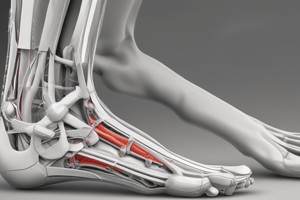Podcast
Questions and Answers
What is a common risk factor for Chronic Ankle Instability (CAI)?
What is a common risk factor for Chronic Ankle Instability (CAI)?
- Previous history of knee injuries
- Excessive flexibility in the ankle joint
- Supinated foot type (correct)
- Regular bracing during sports activities
Which of the following tests is NOT typically used to determine the level of instability in patients with CAI?
Which of the following tests is NOT typically used to determine the level of instability in patients with CAI?
- Anterior Drawer test
- Star Excursion Balance Test (SEBT) (correct)
- Talar tilt test
- Reverse Anterior Drawer Test
What type of episodes are characteristic of CAI?
What type of episodes are characteristic of CAI?
- Chronic episodes with repeated pain over the anterior lateral ankle (correct)
- Intermittent episodes with discoloration
- Stable episodes without any pain
- Acute episodes with severe swelling
Which of the following impairments are NOT typically associated with CAI?
Which of the following impairments are NOT typically associated with CAI?
What is the significance of patient perception in the diagnosis of CAI?
What is the significance of patient perception in the diagnosis of CAI?
When is bracing deemed necessary for patients with CAI?
When is bracing deemed necessary for patients with CAI?
What is the primary difference in examination findings between an acute lateral ankle sprain (LAS) and Chronic Ankle Instability (CAI)?
What is the primary difference in examination findings between an acute lateral ankle sprain (LAS) and Chronic Ankle Instability (CAI)?
Which of the following is true regarding the use of bracing in Chronic Ankle Instability (CAI)?
Which of the following is true regarding the use of bracing in Chronic Ankle Instability (CAI)?
Which of the following risk factors for Chronic Ankle Instability (CAI) is independent of previous injury?
Which of the following risk factors for Chronic Ankle Instability (CAI) is independent of previous injury?
Which of the following is a common motor-behavioral impairment associated with Chronic Ankle Instability (CAI)?
Which of the following is a common motor-behavioral impairment associated with Chronic Ankle Instability (CAI)?
Which of the following is a common sensory-perceptual impairment associated with Chronic Ankle Instability (CAI)?
Which of the following is a common sensory-perceptual impairment associated with Chronic Ankle Instability (CAI)?
Which of the following patient populations would benefit the most from prophylactic bracing during sports due to risk for Chronic Ankle Instability (CAI)?
Which of the following patient populations would benefit the most from prophylactic bracing during sports due to risk for Chronic Ankle Instability (CAI)?
What is the primary reason for using the Anterior Drawer test, Reverse Anterior Drawer Test, and Talar tilt test in the examination of CAI?
What is the primary reason for using the Anterior Drawer test, Reverse Anterior Drawer Test, and Talar tilt test in the examination of CAI?
What is the characteristic difference in pain patterns between acute LAS and CAI?
What is the characteristic difference in pain patterns between acute LAS and CAI?
What is the significance of supinated foot type as a risk factor for CAI?
What is the significance of supinated foot type as a risk factor for CAI?
What is the primary difference between patho-mechanical and motor-behavioral impairments in CAI?
What is the primary difference between patho-mechanical and motor-behavioral impairments in CAI?
What is the role of bracing in patients with CAI?
What is the role of bracing in patients with CAI?
What is the significance of rigorous sports with end range of motion, twisting, and pivoting as a risk factor for CAI?
What is the significance of rigorous sports with end range of motion, twisting, and pivoting as a risk factor for CAI?
Flashcards are hidden until you start studying
Study Notes
Characteristics of Chronic Ankle Instability (CAI)
- CAI is characterized by chronic episodes of ankle instability or giving way, with repeated pain over the anterior lateral ankle following even minor ankle sprains.
- It is often associated with decreased proprioceptive awareness, supinated foot type, and previous episodes of ankle sprains.
Risk Factors for CAI
- Decreased proprioceptive awareness
- Supinated foot type
- Previous episode of ankle sprain
- Participation in rigorous sports that involve end-range of motion, twisting, and pivoting
Observations in CAI
- Patho-mechanical impairments
- Sensory-perceptual impairments
- Motor-behavioral impairments
- Patients rarely have repeated swelling and discoloration like they did on their initial LAS event
Examination of CAI
- No specific test for CAI
- Anterior Drawer test, Reverse Anterior Drawer Test, and Talar tilt test are still used to determine the level of instability
- Patient perception matters - if they feel their ankle is unstable, they most likely have CAI
Management of CAI
- Bracing may be needed to functionally allow the patient to participate in sports with CAI
- Initially, bracing is not as critical as in acute LAS, but may be necessary for functional maintenance
Studying That Suits You
Use AI to generate personalized quizzes and flashcards to suit your learning preferences.




